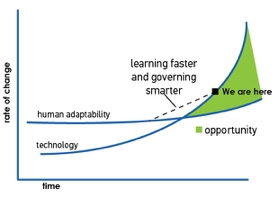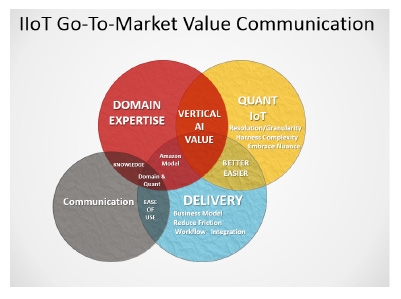Defining The IoT Opportunity for Field Service Providers
Aug 08, 2017
Article
Dan Yarmoluk, ATEK Access Technologies
I am excited to have been invited to share my views with you on why I’m so optimistic for field service workers and organizations by leveraging IoT technologies. I feel the field service component, distribution, channel, aftermarket service/repair, and integrator (or choose your terminology) is the glue to the entire IoT value chain. My goal for this column is to not only share my views, but to open a dialog with the community for us to share, learn, and collaborate.
Moving To The “Mathematical Corporation”
We all hear words like the Internet of Things (IoT), the Industrial Internet of Things (IIoT), the Internet of Everything (IoE), Industry 4.0, M2M, etc. Industry 4.0 is a good example in terms of a conceptual framework. The first industrial revolution came with invention of the loom, and one loom replaced 40 textile workers. The second industrial revolution ushered in the steam engine, where a single steam engine replaced 50 horses. The third industrial revolution was the invention of the assembly line, and “Industry 4.0” refers to the current phase, which is powered or augmented by machines or “systems of intelligence.” It is connecting the trillion-sensor economy we hear forecasted about, computed in the cloud to provide always-on, always-thinking for true quantitative measure. IoT is creating a universe of sensors, which enable an accelerated, deep learning of existing operations. These data tools allow for rapid contextualization, automatic pattern, and trend detection. Furthering of this concept enables operations to finally allow for quantitative capture which was formerly “expert” or tribal qualitative operations. There is a terrific book entitled The Mathematical Corporation by Josh Sullivan and Angela Zutavern, explaining this concept in which machine intelligence and human ingenuity is the business model of the future.
Technology Advances Outpacing Human Ability To Adapt
Technology advances are moving in what Peter Diamandis terms “Exponential Technologies” in his book Bold, at such a compounding pace from a variety of areas. Cloud computing, quantum computing, robotics, and artificial intelligence are enabling things like precision medicine, mapping the genome, global communication, etc. We are so busy in the day-to-day operations and “minding the store” that we cannot possible sit and imagine the possibilities. The issue is, we are really at a moment of adapt or die, and need to approach this digital transformation front and center in conjunction with the day-to-day business. The opportunity lies in the fact that your customers cannot respond to these technological changes either, and the field service worker can now adapt into the “smart field worker,” enabling this transformation. The following chart is a conversation between Astro Teller of Google and Thomas Friedman in his book, Thank you for Being Late. I shaded the green in to illustrate the economic opportunity.

IoT Market Hesitation
Again, the continual technological changes create confusion that leads to hesitation. There are digital leaders, fast followers, and laggards — and even the leaders are just embarking on their IoT journey or divisions. It is understandable that entire businesses and processes will change with the injection of valuable data. This will be small projects and evolution over time, and this is where I feel the field service people and organizations can capitalize.
Let’s use an example. An industrial pump manufacturer has been in the pump business for decades, they do not have the technology background to make a smart pump, but eventually teamed up or acquired the knowledge to make a smart pump. To get a return on that expensive product, they charge premium for their “smart” product, pushing that cost to the customer for more advanced predictive analytics and features. Again, I’m underscoring prohibitive cost for the customer and hard to understand as the user of the machine is not used to interpreting predictive analytics streams. Thus, the question becomes, how do we deliver the value of IoT to our customers?
The Opportunity
The opportunity lies in outcome-based results. Rather than equip a customer with smart technology, let’s consider the fact that most maintenance managers have no time, no budget, no analytic understanding, and no people — so the value is to do it for them. The key here is the solution must be integrated into their workflow. Remember we are on this evolutionary journey that is stagnating through hesitation, so you must show them the way.
I feel the opportunity service organizations have to leverage IoT to transform their business is incredible. It is a tool that will allow field workers to spot issues continuously as an expanded “remote monitoring” opportunity, maybe as a SaaS model. This could be a new revenue stream, but really a chance to see more issues with continual data streaming in instead of quarterly route-based maintenance. If you do quarterly route maintenance on machines, which is considered somewhat progressive, that is 4 data points per year on a machine. Well, if I could give you more resolution and granularity with data and sensors every hour, that is 24 data points in one day versus the 4 data points a year. That is true value and insight. With that insight, you will see more problems, more opportunities to preemptively fix and opportunity to book service, while keeping the customer chugging along preventing unplanned downtime, productivity enhancements, as well as health and safety improvements. I urge you to embrace and lead this IoT transformation. You are closest to your customer, hence closer to their pain points and can find new and innovative way to solve their problems. IoT is enabling service organizations to develop unique business models that simultaneously further IoT adoption and expand your business.
I designed a diagram to illustrate that the value lies in domain specific expertise and vertical specialization, but delivery is key. Think like Amazon, reducing friction at every turn to illustrate value. A good book on the subject is IoT the Amazon Way, by John Rossman. The communication must sway from ease-of-use, brass tax, and mathematical proof, served on a platter through your organization.
